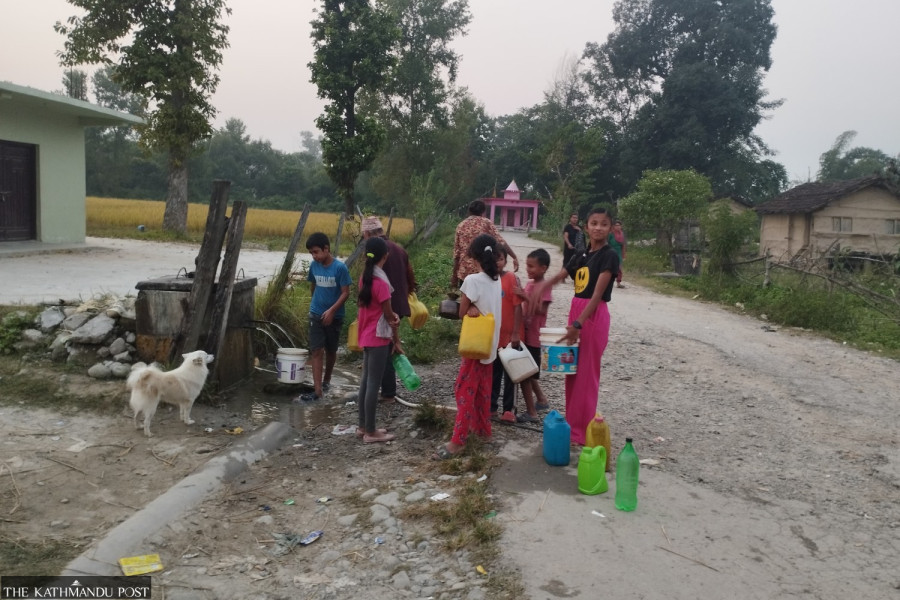Sudurpaschim Province
Groundwater depletion affecting many settlements in western Tarai
Climate change, rapid urbanisation and over-extraction of riverbed material are to blame, experts say.
DR Pant
Dabbu Thapa, a farmer from Krishnapur ward 2 in Kanchanpur, has been drilling holes in his fields in the hopes of finding groundwater to irrigate his fields. But no matter how deep he drills, he can’t find a single droplet of water, says Thapa, 54. “There is no water in the borewells and the rainfall is neither reliable nor sufficient,” he says. “We are suffering due to a lack of water for agriculture and even for drinking.”
Local residents report that, in some areas of the Kanchanpur and Kailali districts, a majority of borewells, both public and private, have dried up.
Half a dozen water supply projects in Krishnapur and Shuklaphanta Municipality in Kanchanpur are drying up, Thapa says. It has been four years since most borewells and hand pumps in Krishnapur’s ward 2 and 4 began to dry up.
The Attariya Urban Drinking Water Project constructed five borewells in Attariya Bazaar of Godawari Municipality, Kailali, four years ago. Four of them have now dried up.
Project officials attribute the drying up of the borewells to the depletion of groundwater in the Attariya area. Three years ago, the local unit’s consumer committee conducted a technical test after the borewells started drying up. The test revealed the borewells could not pump water to the surface due to the exhaustion of groundwater sources.
The project then constructed a water storage tank with a capacity of 400,000 litres, about 5 km from Attariya Bazaar, where groundwater depletion is not extreme, to supply water to 4,500 households.
In Kanchanpur, projects have now started searching for alternative sources of water near the foothill area of Chure.
Four years ago, Krishnapur Municipality started installing a deep well hand pump in every settlement. But one hand pump is not enough to cater to at least 15 to 20 households in every settlement, says Dawal Chand, a local resident of ward 2. “There is always a long queue of people waiting for their turn to collect water,” Chand says. “Drinking water projects have not been able to supply drinking water since the borewells have dried up, so we have to rely on the hand pump to meet our water needs.”
Engineer Parikshit Shrestha, consultant for the Urban Water Supply and Sanitation Project, says that until 15 years ago groundwater was available a mere 30 feet below the surface but now, one has to drill at least 80 to 120 feet deep into the ground for water. “But even that doesn’t guarantee there will be water,” he said.
Several factors have contributed to the continuous depletion of groundwater in the Tarai region of the Sudurpaschim province, says Shrestha.
Exploitation of groundwater systems, changes in the water cycle, irregular rainfall, exploitation of rivers and riverbed materials, climate change, and increased destruction of the Chure region have led to a water crisis in the area, he says. “For now, two local units in Kanchanpur are facing an immediate water crisis but the other places are also gradually running out of groundwater,” he said. “Similarly, different parts of Kailali are also facing the same problem.”
Another factor contributing to the depletion of groundwater is the increase in population given the unchecked urbanisation in the Tarai region. “Population increase has led to rapid urbanisation and its attendant phenomenons—deforestation and over extraction of riverbed materials,” Shrestha said. “That has also affected the storage capacity of the groundwater system.”
According to the data of the Department of Water Supply and Sewerage Management, 51 percent of the Nepali population uses tap water, 35 percent uses hand pumps, and only 14 percent uses natural resources and other resources. Likewise, in west Tarai, 67 percent of farmers depend on groundwater for irrigation while 90 percent of people use groundwater for all household purposes.
According to Dr Birbhadra Singh, a researcher who has studied the underground water storage system in Nepal and the importance of Chure foothills, the capacity of underground water storage is decreasing due to the exploitation of natural resources. “Although there is no separate study and data exclusively for Kailali and Kanchanpur districts, experts suggest that the groundwater storage capacity in these two districts is much lower than reflected in the national data,” Singh said.
Experts on Chure Tarai conservation say that if the exploitation of the rivers of Tarai and Chure continues then areas of west Tarai will face a severe water crisis within the next decade.
“Due to the disturbance on the underground water level and storage cycle, problems such as land infertility, an inability to grow trees, and the depletion of groundwater resources will continue,” said Dr Jagannath Joshi, member of the Chure Tarai Protection Committee.




 6°C Kathmandu
6°C Kathmandu













